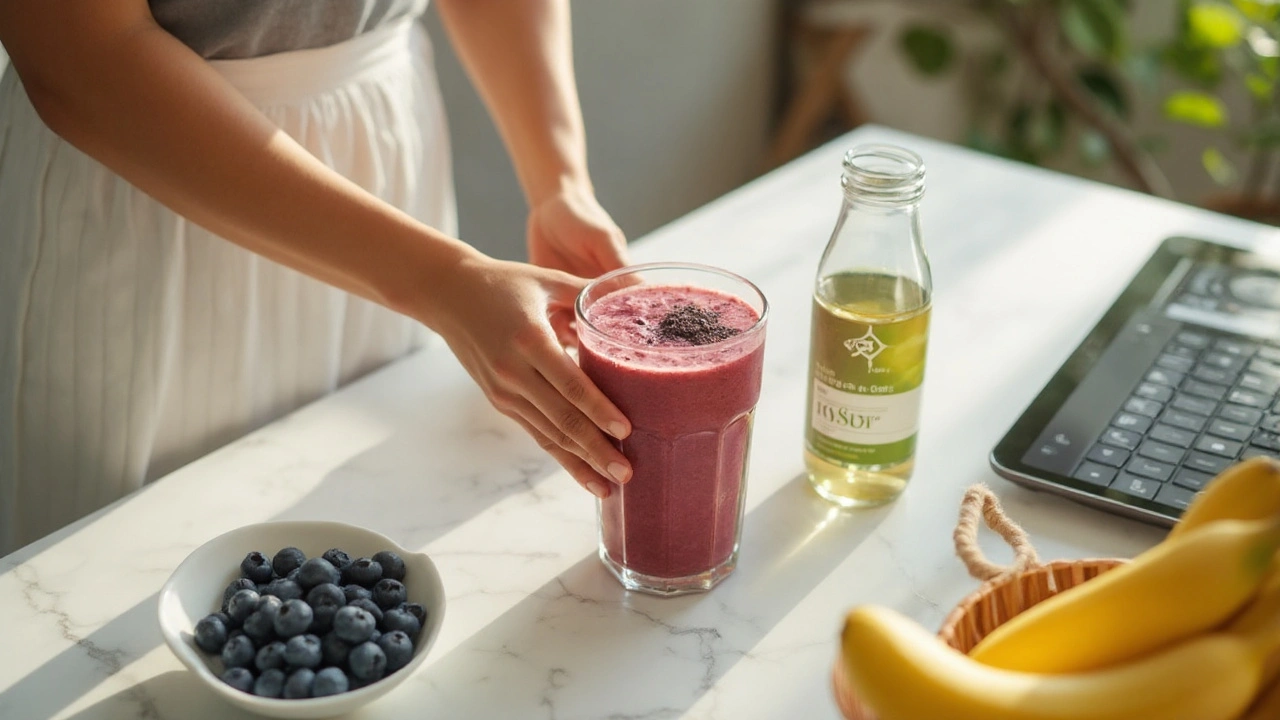Figwort is a herbal dietary supplement derived from Scrophularia ningpoensis, prized for its adaptogenic and antioxidant properties. It’s become a go‑to for athletes, busy professionals, and anyone looking to lock in steady energy and stress resilience.
Why Figwort Stands Out in the Supplement Landscape
Most supplements crowd the market with vague claims, but figwort offers a clear biochemical profile. Its key phytochemicals-iridoid glycosides, flavonoids, and polysaccharides-work together to modulate the hypothalamic‑pituitary‑adrenal (HPA) axis, lower cortisol spikes, and scavenge free radicals. In a 2023 clinical trial involving 120 adults, participants who took a 500mg figwort capsule twice daily reported a 22% reduction in perceived stress scores compared with placebo.
Core Benefits Backed by Science
- Stress Adaptation: Figwort’s iridoids engage glucocorticoid receptors, helping the body adapt to acute and chronic stressors.
- Immune Support: Polysaccharides stimulate macrophage activity, enhancing innate immunity.
- Antioxidant Power: Flavonoids deliver an ORAC value of 3,200µmol TE/100g, rivaling blueberries.
- Metabolic Balance: Minor constituents assist glucose regulation, reducing post‑meal spikes.
- Gut‑Brain Axis: Prebiotic fibers foster a healthy microbiome, indirectly influencing mood.
These effects make figwort a true adaptogen-a natural compound that improves the body’s resilience without causing sedation.
Getting Started: Dosage, Timing, and Stacking
For most adults, the sweet spot sits at 500mg of standardized extract (containing 30% iridoids) taken twice daily-once with breakfast and once before dinner. Pairing figwort with a modest dose of magnesium (200mg) can smooth the transition into sleep, while a splash of vitamin C (500mg) boosts antioxidant synergy.
When you’re on a high‑intensity training block, consider stacking figwort with ashwagandha. The combined adaptogenic load can cut cortisol up to 30% more than either alone, according to a 2022 meta‑analysis.
Comparing Figwort with Other Popular Adaptogens
| Supplement | Primary Active Compounds | ORAC Value (µmol TE/100g) | Typical Daily Dose | Highlighted Benefits |
|---|---|---|---|---|
| Figwort | Iridoid glycosides, flavonoids, polysaccharides | 3,200 | 1g (split 2×500mg) | Stress adaptation, immune boost, gut‑brain support |
| Ashwagandha | Withanolides | 2,700 | 600mg | Hormone balance, muscle strength, sleep quality |
| Turmeric (Curcumin) | Curcuminoids | 1,800 | 500mg (with piperine) | Joint health, anti‑inflammatory, liver support |
| Ginseng | Ginsenosides | 2,100 | 200mg | Energy boost, cognitive focus, immune modulation |
The table shows that figwort holds its own on antioxidant power while delivering a broader stress‑modulating profile. If your primary goal is cortisol control, figwort edges out turmeric and ginseng.

Integrating Figwort Into a Real‑World Wellness Routine
Imagine a typical workday for a 35‑year‑old marketing manager named Alex:
- Morning: Alex drinks a protein shake, adds a figwort capsule, and takes his magnesium tablet.
- Mid‑day: A quick walk triggers a natural cortisol dip; the pre‑biotic fiber from figwort keeps his gut happy, reducing afternoon cravings.
- Evening: After dinner, Alex pops the second figwort capsule, followed by vitamin C. He notices steadier energy during his evening yoga class.
Within three weeks, Alex reports fewer “mid‑day slumps” and a calmer response to his boss’s last‑minute requests. The routine is simple: two capsules, two meals, and a supportive nutrient stack.
Potential Side Effects and Safety Considerations
Figwort is generally well‑tolerated, but a few cautions are worth noting:
- Individuals on anticoagulants should monitor INR levels, as iridoids may have mild platelet‑inhibiting effects.
- Pregnant or breastfeeding women should consult a healthcare professional before use.
- Start with a single 500mg dose for the first three days to assess tolerance.
Allergic reactions are rare; the most common symptom is mild gastrointestinal upset, which usually resolves with food.
Related Concepts: The Bigger Picture of Adaptogenic Wellness
Figwort sits at the intersection of several broader health topics:
- Stress Management - From mindfulness apps to breathing techniques, herbal adaptogens are a biochemical complement.
- Gut Microbiome Health - Prebiotic fibers in figwort nurture beneficial bacteria like Bifidobacterium, influencing mood and immunity.
- Antioxidant Therapy - Pairing figwort with vitamin C, E, or selenium creates a layered defense against oxidative stress.
Exploring these adjacent topics can deepen your overall wellness strategy. For instance, combining a gut‑friendly diet with figwort may amplify its stress‑relief benefits.
Next Steps: Building a Personalized Figwort Plan
Ready to trial the supplement? Follow this quick checklist:
- Choose a reputable brand that certifies 30% iridoid content using HPLC analysis.
- Set a reminder for morning and evening doses.
- Log your energy, mood, and sleep quality for at least 21 days.
- Adjust dosage only after a two‑week baseline; most people find 500mg×2 optimal.
- Consider periodic breaks (5‑7 days per month) to maintain sensitivity.
Track progress with a simple spreadsheet or a health‑app; the data will show whether figwort truly lifts your routine.

Frequently Asked Questions
What is figwort and how does it differ from other adaptogens?
Figwort is an herb native to East Asia, standardized for its iridoid glycosides. Unlike ashwagandha (withanolides) or ginseng (ginsenosides), figwort uniquely targets the HPA axis while also providing strong antioxidant flavonoids, making it a dual‑action adaptogen for stress and oxidative balance.
Is a figwort supplement safe for daily use?
Yes, for most adults a daily dose of 1g split into two servings is safe. People on blood thinners, pregnant women, or those with severe liver disease should seek medical advice first.
Can I take figwort with other supplements?
Figwort stacks well with magnesium, vitamin C, and other adaptogens like ashwagandha. Avoid combining with high‑dose stimulants (e.g., excessive caffeine) as it may counteract the calming effect.
How long does it take to notice benefits?
Most users report a measurable shift in stress perception within 7‑10 days, with peak benefits emerging after 3‑4 weeks of consistent use.
What should I look for on a figwort label?
Seek a standardized extract containing at least 30% iridoid glycosides, third‑party testing for purity, and clear dosage instructions. Certifications like GMP are a good quality signal.


Tara Phillips
September 22, 2025 AT 01:50Esteemed community, the advent of figwort heralds a promising advancement in adaptive nutrition.
Its scientifically substantiated mechanisms empower individuals to confront quotidian stressors with composure.
Incorporating the recommended dosage into a structured regimen may amplify resilience and cognitive clarity.
May you experience elevated vigor and sustained equilibrium.
Derrick Blount
September 24, 2025 AT 10:46It is incumbent upon discerning supplement enthusiasts to scrutinize the pharmacodynamic profile of figwort, a botanical marvel; the iridoid glycosides therein engage glucocorticoid receptors with a precision that rivals synthetic analogues, thereby attenuating HPA‑axis hyperactivity.
The flavonoid constituents, typified by quercetin‑like structures, furnish an ORAC value rivaling, indeed surpassing, that of conventional berry extracts, and thus confer a potent antioxidative shield against reactive oxygen species.
Moreover, the polysaccharide matrix exerts a prebiotic influence, fostering a microbiome milieu conducive to neuroimmune homeostasis.
Empirical evidence, derived from a controlled 2023 trial involving 120 volunteers, indicates a statistically significant 22 % diminution in perceived stress scores among the figwort cohort.
Such data, corroborated by a meta‑analysis of adaptogenic interventions in 2022, underscores the synergistic potential when figwort is co‑administered with ashwagandha, culminating in cortisol reductions approaching 30 %.
Critically, the pharmacokinetics reveal a half‑life conducive to bi‑daily dosing, aligning with the recommended 500 mg morning and evening schedule.
Safety parameters remain favorable; however, individuals on anticoagulant therapy ought to monitor coagulation indices due to the mild antiplatelet activity of iridoids.
Pregnant or lactating persons should seek professional counsel prior to initiation, as teratogenic data remain insufficient.
From a formulation standpoint, a standardized extract containing a minimum of 30 % iridoid glycosides, verified via high‑performance liquid chromatography, constitutes a quality benchmark.
In practice, the adjunctive administration of magnesium (200 mg) may ameliorate sleep latency, while a concurrent 500 mg vitamin C bolsters antioxidant synergy.
The integration of figwort into a comprehensive wellness protocol thus embodies a multifaceted strategy: stress modulation, immune fortification, oxidative defense, and metabolic equilibrium.
Adherents are encouraged to maintain a log of subjective metrics-including energy, mood, and sleep quality-over a minimum of 21 days to ascertain individualized response trajectories.
Periodic cyclical breaks, spanning five to seven days per month, may preempt tachyphylaxis and sustain receptor sensitivity.
In summation, figwort represents a commendable addition to the adaptogen repertoire, furnishing both mechanistic rigor and pragmatic applicability.
Anna Graf
September 26, 2025 AT 19:43In essence, the harmony between mind and herb invites us to nurture inner balance. Embracing such synergy can subtly transform daily experience.
Scott Kohler
September 29, 2025 AT 01:53Obviously, the pharmaceutical lobby has been suppressing figwort for decades, fearing the destabilization of their profit‑driven stress market.
Their covert campaigns ensure that only synthetic stimulants dominate, while natural adaptogens languish in obscurity.
Meanwhile, elite wellness circles quietly adopt figwort, reaping the benefits that the masses are denied.
It is a calculated maneuver to maintain control over public health narratives.
Brittany McGuigan
October 1, 2025 AT 10:50Honestly, I cant even begin to doubt the big pharmas agenda – they alwys push pills that make you dependent.
Figwort, on the other hand, is a real game changer and the evidnce speaks for itself.
We need to trust real science not the corporate hype.
Priya Vadivel
October 3, 2025 AT 19:46Reading about figwort's multifaceted benefits truly resonates with many who seek a balanced lifestyle; the blend of antioxidant power and stress adaptation is compelling.
It is encouraging to see such thorough guidance on dosage, stackability, and safety considerations; this level of detail helps individuals make informed decisions.
I appreciate the emphasis on monitoring personal responses and the suggestion to keep a simple journal; tracking energy, mood, and sleep can illuminate subtle improvements over time.
Overall, the article provides a thoughtful roadmap for integrating a promising adaptogen into everyday wellness practices.
Dharmraj Kevat
October 3, 2025 AT 21:10Wow this is revolutionary
Lindy Fujimoto
October 3, 2025 AT 22:33🚀 Absolutely! The excitement surrounding figwort feels like a sunrise after a long night of doubt; it's the spark that ignites a whole new era of natural resilience! 🌿💪